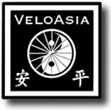

| Good Morning, Apocalypse: Wartime Souvenirs in Vietnam by Michael Buckley
Now that the trade embargo has been lifted by the Clinton administration, and Washington is negotiating to get back its old embassy in Saigon (for use as a trade center), the Vietnamese are going to have to rethink their military museums. The most popular museum in Saigon is the War Crimes Museum, located in the grounds of an old French villa that once housed the U.S. Information Service. The English captions accompanying the exhibits are very brief, but the horrific photos speak for themselves: pictures of the My Lai massacre, gruesome shots of victims of napalm and Agent Orange, and harrowing pictures of deformed babies. Parked in the grounds is an array of weaponry, including an M41 tank, a flamethrower, and a Huey helicopter.(After Vietnam normalized relations with China in 1991, the Chinese-atrocity section of this museum, related to border wars in 1979, was discreetly closed). There have been some other alterations at the museum--in 1993, a Wartime Souvenir Shop opened on the grounds. Would you be interested in a flower vase made from a 40 mm cartridge, burnished to a bright gold? Or a pair of Ho Chi Minh tire-tread sandals? Perhaps a green NVA pith helmet, or NVA campaign and victory badges? Other items on sale include Vietnam-in-Wartime postcards featuring a Vietcong woman in full combat gear striking a heroic pose, and a range of T-shirts: Ho Chi Minh, Tintin in Vietnam, Miss Saigon. You can also buy U.S. flashlights, compasses, and field glasses. Authenticate? Probably not--they're rumored to be made in Saigon. For big bucks, you can get some revolutionary art at Saigon's Military Museum: $500 buys a large canvas depicting the Fall of Saigon, while $200 buys a painting of Vietcong tunnels or a "guerilla girl." Payment is preferred in U.S. dollars, the unofficial hard currency of Vietnam. Also banking on nostalgia are several bars, the most notorious of which is Apocalypse Now, whose wall features a large poster from the movie, autographed by Martin Sheen. The patrons are mostly Westerners, the place is smoky (and not just from cigarettes), the music is loud--and when they crank up mesmerizing lyrics by the Doors, Saigon of the sixties is not too far away. Around the corner from Apocalypse Now is an art gallery and souvenir shop that sells framed Vietnam War-vintage black-and-white prints. The owner is Hoang Van Cuong, a photographer whose Vietnam war images are known around the world. Wanted by his government, after the war, Hoang escaped detection by working as a farmer in the south for nine years; he was leter caught and sent to re-education camps for six years. But he hid his negatives until he regained his freedom,and his photos have found a new market with tourism. The most popular day-trip from Saigon is to Cu Chi--a bizarre maze of over 200 kilometers of tunnels used by the Vietcong to launch raids and to escape American bombing. The tunnels were dug by hand with simple tools and took decades to construct. Most have now been sealed, but a few passageways have been doubled; in width and height to accommodate western tourist bodies. After spending just 15 claustrophobic, sweaty minutes of crawling around on your hands and knees, you wonder how anyone could possibly have endured years of living in the tunnels. Further north, from Hue, you can take a full day DMZ tour that covers half a dozen strategic sites, from the Vinh Moc tunnels to Khe Sanh. A minibus rumbles through countryside that oscillates from bomb-scarred wasteland to luminous green rice paddies. The guide informs us that 17 children were born inside Vinh Moc tunnels during the war, and that one square meter of ground in this area was subjected to almost 10 tons of American bombs from 1966 to 1972. After crawling overlooking a beach—waiting there are enterprising kids selling cans of Coke. Out at Khe Sanh U.S. Army base, there is nothing to see except reddish dirt with bits of barbed wire embedded in it. "But hey, no problem," says the guide cheerfully, "we're going to rebuild the entire base, foxholes and all." These places attract another kind of visitor. Armed with metal detectors, Vietnamese forage for scrap metal, which goes to smelting factories and is turned into structural elements like steel girders for bridges. Our guide later shows us a spoon made from U.S. aircraft aluminum. In my mind, I am conjuring up a recycling scenario: scrap aluminum from U.S. jets is found in Vietnam, exported to Japan and turned into beer cans, which then come back to Vietnam, and after use are discarded, picked up again, and remade into model Huey helicopters Up the other end of the country, in Hanoi, the Army Museum has entire fuselage sections from downed B-52s, and a room with helmets of U.S. airmen stacked up like hardware in a used sporting-goods shop. Even Ho Chi Minh gets in on the souvenir act: you can buy busts of Ho, copies of his poetry, Uncle Ho postcards, stamps, and posters, Ho hats and badges, and T-shirts featuring a smiling Uncle Ho, one hand up and waving--but would it be so if he were alive today? Strolling through Hanoi's old quarter, I was drawn to a window-displayof T-shirts—always a barometer of changing times. "Hard Rock Cafe" read one T-shirt; "CNN Hanoi" said another. When the owner was asked where you could view CNN or find the Hard Rock Cafe in Hanoi, he shrugged and said: "Maybe next year." Behind the counter, another T-shirt caught my eye: it had "Good Morning Apocalypse" emblazoned on the front, and on the back, printed in large letters, was "Vietnam Now"! Michael Buckley is author of the newly-published Heartlands. He has also written the Tibet Travel Adventure Guide, Moon's Vietnam, Cambodia, and Laos Travel Handbook, Cycling to Xian , Tibet, and has guided VeloAsia tours in Sumatra and Vietnam. |